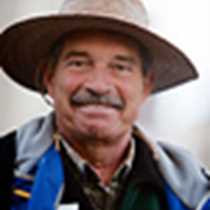Glacier Bay National Park
So what if the day is gray and a little wet? This is called Alaska sunshine, AND we are in one of the most marvelous and great national parks of the United States! From early morning on we had entered Glacier Bay, that waterway (today) that was carved out and expanded by a monstrous glacier, the Grand Pacific Glacier. When Capt. George Vancouver sailed into this area in 1794, Glacier Bay was closed due to it being filled almost to today's entrance with ice. He couldn’t have seen as we see it today. This glacier was more than 4,000 feet thick and up to 20 miles wide. Today we find the glacier receded almost 65 miles, almost to the actual border with Canada!
The waters of the bay are very rich, porpoise and sea otters were seen early in the morning. The clouds lay low and elastic, like taffy between the trees. As we wended our way further into the bay, we arrived to South Marble Island, where we slowed down, and our ranger, Jeanine Driscoll pointed out so many different birds to us, including the heavily anticipated puffins (both horned and tufted), barely being able to take off from the water. But different species of gulls were to be seen, as well as pigeon guillemots, American oystercatchers, murres, and cormorants. The island also has a big rookery of male Steller sea lions, monsters of the seas that lay all day long on the rocks moaning and groaning about the vicissitudes of life.
On we went deeper into the bay, and next to Russell Island where we surprised a brown bear eating on the beach. The natives were wont to say that when the tide was down, the table was set. And our friend the brown (or grizzly) bear agreed with it. These animals have strong, heavy shoulders with a hump, and are the ones that overturn big rocks and logs at the beach, feeding on worms, crabs and other invertebrates. We watched it for a good while, deciding it was a quite young animal. It was also quite thin, not having recovered its weight from last year. Oh, salmon, hurry into my river!
The great glacier we visited was just made available to us a short time ago, Johns Hopkins Glacier. This ice monster is advancing up to 12 feet a day, and had filled the bay with huge amounts of small ground ice.
On our return trip we stopped at Boulder Island, where we all had a splendid time watching the very plentiful (maybe up to 1,500?) sea otters. After dinner we had reached Bartlett Cove, where we still had more adventure: a good hike or two!
So what if the day is gray and a little wet? This is called Alaska sunshine, AND we are in one of the most marvelous and great national parks of the United States! From early morning on we had entered Glacier Bay, that waterway (today) that was carved out and expanded by a monstrous glacier, the Grand Pacific Glacier. When Capt. George Vancouver sailed into this area in 1794, Glacier Bay was closed due to it being filled almost to today's entrance with ice. He couldn’t have seen as we see it today. This glacier was more than 4,000 feet thick and up to 20 miles wide. Today we find the glacier receded almost 65 miles, almost to the actual border with Canada!
The waters of the bay are very rich, porpoise and sea otters were seen early in the morning. The clouds lay low and elastic, like taffy between the trees. As we wended our way further into the bay, we arrived to South Marble Island, where we slowed down, and our ranger, Jeanine Driscoll pointed out so many different birds to us, including the heavily anticipated puffins (both horned and tufted), barely being able to take off from the water. But different species of gulls were to be seen, as well as pigeon guillemots, American oystercatchers, murres, and cormorants. The island also has a big rookery of male Steller sea lions, monsters of the seas that lay all day long on the rocks moaning and groaning about the vicissitudes of life.
On we went deeper into the bay, and next to Russell Island where we surprised a brown bear eating on the beach. The natives were wont to say that when the tide was down, the table was set. And our friend the brown (or grizzly) bear agreed with it. These animals have strong, heavy shoulders with a hump, and are the ones that overturn big rocks and logs at the beach, feeding on worms, crabs and other invertebrates. We watched it for a good while, deciding it was a quite young animal. It was also quite thin, not having recovered its weight from last year. Oh, salmon, hurry into my river!
The great glacier we visited was just made available to us a short time ago, Johns Hopkins Glacier. This ice monster is advancing up to 12 feet a day, and had filled the bay with huge amounts of small ground ice.
On our return trip we stopped at Boulder Island, where we all had a splendid time watching the very plentiful (maybe up to 1,500?) sea otters. After dinner we had reached Bartlett Cove, where we still had more adventure: a good hike or two!




